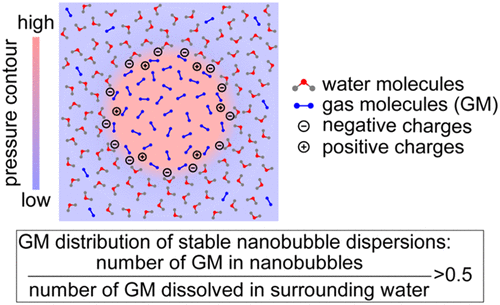Our official English website, www.x-mol.net, welcomes your
feedback! (Note: you will need to create a separate account there.)
Understanding the Stabilization of a Bulk Nanobubble: A Molecular Dynamics Analysis
Langmuir ( IF 3.7 ) Pub Date : 2021-09-14 , DOI: 10.1021/acs.langmuir.1c01796 Zhan Gao 1 , Wangxia Wu 2 , Weitao Sun 1 , Bing Wang 1
Langmuir ( IF 3.7 ) Pub Date : 2021-09-14 , DOI: 10.1021/acs.langmuir.1c01796 Zhan Gao 1 , Wangxia Wu 2 , Weitao Sun 1 , Bing Wang 1
Affiliation

|
Bulk nanobubbles (NBs) have received considerable attention because of their extensive potential applications, such as in ultrasound imaging and water management. Although multiple types of experimental evidence have supported the existence and stabilization of bulk NBs, the underlying mechanism remains unclear. This study numerically investigates the bulk NB stabilization with molecular dynamics (MD) methods: the all-atom (AA) MD simulation is used for NBs of several nanometers diameter; the coarse-grained (CG) MD simulation is for the NBs of about 100 nm. The NB properties are statistically obtained and analyzed, including the inner density, inner pressure, surface charge, interfacial hydrogen bond (HB), and gaseous diffusion. The results show that the gas inside an NB has ultrahigh density (tens of kilograms per cubic meter). A double-layer surface charge exists on the NB. The inner/outer layer is positively/negatively charged, and the electrostatic stress can counteract part of the surface tension. In addition, the interfacial HB is weakened by the interaction between gas and water molecules, causing less surface tension. The above features are beneficial to NB stabilization. The NB equilibrium radii solved by the interfacial mechanical equilibrium equation agree with the MD results, indicating that this equation can describe the force balance of an NB as small as several nanometers. Besides, supersaturation appears to be necessary for the NB thermodynamic equilibrium. Based on Henry’s law and the ideal gas law, the theoretical analysis suggests that the stability of the NB thermodynamic equilibrium is conditional: the number of gas molecules in NBs should be more than half that dissolved in liquid. This study unravels a stabilized bulk NB’s properties and discusses the NB equilibrium and stabilization mechanism, which will advance the understanding and application of bulk NBs.
中文翻译:

了解大量纳米气泡的稳定性:分子动力学分析
由于其广泛的潜在应用,例如在超声成像和水管理中,块状纳米气泡 (NB) 受到了相当多的关注。尽管多种类型的实验证据支持大块 NB 的存在和稳定,但其潜在机制仍不清楚。本研究使用分子动力学 (MD) 方法对本体 NB 的稳定性进行了数值研究:全原子 (AA) MD 模拟用于几纳米直径的 NB;粗粒度 (CG) MD 模拟适用于约 100 nm 的 NB。统计获得和分析 NB 特性,包括内部密度、内部压力、表面电荷、界面氢键 (HB) 和气体扩散。结果表明,NB内部的气体具有超高密度(每立方米数十公斤)。NB 上存在双层表面电荷。内/外层带正/负电荷,静电应力可以抵消部分表面张力。此外,界面 HB 因气体和水分子之间的相互作用而减弱,导致表面张力降低。以上特点有利于NB稳定。界面力学平衡方程求解的NB平衡半径与MD结果一致,表明该方程可以描述小至几纳米的NB的力平衡。此外,过饱和似乎是 NB 热力学平衡所必需的。基于亨利定律和理想气体定律,理论分析表明NB热力学平衡的稳定性是有条件的:NBs中的气体分子数应该是溶解在液体中的气体分子数的一半以上。本研究揭示了稳定的块状 NB 的性质,并讨论了 NB 的平衡和稳定机制,这将促进对块状 NB 的理解和应用。
更新日期:2021-09-28
中文翻译:

了解大量纳米气泡的稳定性:分子动力学分析
由于其广泛的潜在应用,例如在超声成像和水管理中,块状纳米气泡 (NB) 受到了相当多的关注。尽管多种类型的实验证据支持大块 NB 的存在和稳定,但其潜在机制仍不清楚。本研究使用分子动力学 (MD) 方法对本体 NB 的稳定性进行了数值研究:全原子 (AA) MD 模拟用于几纳米直径的 NB;粗粒度 (CG) MD 模拟适用于约 100 nm 的 NB。统计获得和分析 NB 特性,包括内部密度、内部压力、表面电荷、界面氢键 (HB) 和气体扩散。结果表明,NB内部的气体具有超高密度(每立方米数十公斤)。NB 上存在双层表面电荷。内/外层带正/负电荷,静电应力可以抵消部分表面张力。此外,界面 HB 因气体和水分子之间的相互作用而减弱,导致表面张力降低。以上特点有利于NB稳定。界面力学平衡方程求解的NB平衡半径与MD结果一致,表明该方程可以描述小至几纳米的NB的力平衡。此外,过饱和似乎是 NB 热力学平衡所必需的。基于亨利定律和理想气体定律,理论分析表明NB热力学平衡的稳定性是有条件的:NBs中的气体分子数应该是溶解在液体中的气体分子数的一半以上。本研究揭示了稳定的块状 NB 的性质,并讨论了 NB 的平衡和稳定机制,这将促进对块状 NB 的理解和应用。











































 京公网安备 11010802027423号
京公网安备 11010802027423号